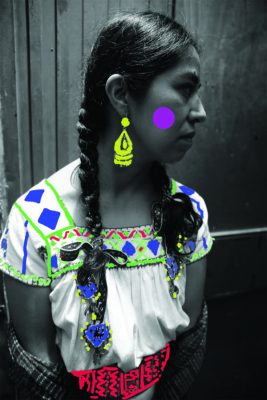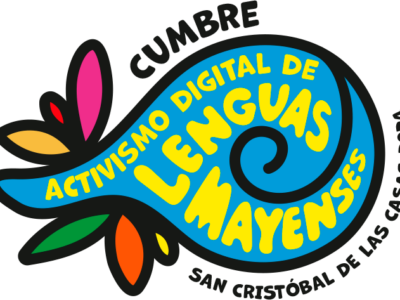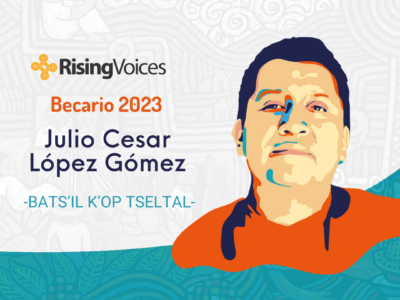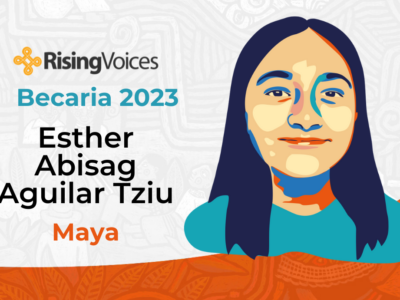
Photograph shared by Isela Xospa
In 2020, we continue our social media campaign by inviting different hosts to manage the @ActLenguas (Language Activism) Twitter account and share their experiences with the revitalization of and advocacy for native languages. This profile post is about Isela Xospa (@EXospatronik) and what she plans to discuss during her week as a host.
Rising Voices (RV): Please tell us about yourself.
Mi nombre es Isela Xospa y soy originaria de la Alcaldía de Milpa Alta región nahua del sur este de la Ciudad de México, soy diseñadora, ilustradora y editora independiente.
Actualmente dirijo Ediciones XospaTronik (2014), proyecto que surge como una editorial autogestiva e independiente que aborda temas y personajes de origen indígena promoviendo el aprendizaje y revitalización de la lengua náhuatl variante del centro alto o náhuatl clásico.
Desde hace varios años me he sumado a las causas, proyectos y metas de distintos organismos enfocados a la preservación del medio ambiente, la revitalización de las lenguas indígenas y la salvaguarda de saberes tradicionales y cultura de los pueblos originarios. Es así como ha surgido el proyecto “Intercambio de saberes y activismo digital en lenguas indígenas” que busca fortalecer alianzas e intercambio entre los pueblos originarios de nuestro continente para producir materiales gráficos y editoriales en lengua indígena dirigidos al público infantil y juvenil.
El proyecto se ha enfocado en la producción de material que puede ser leído y descargado en línea, mismo que ha sido traducido a distintas lenguas indígenas por activistas que de manera voluntaria han donado su trabajo y ayudado a distribuir el material en sus comunidades.
My name is Isela Xospa and I am originally from the municipality of Milpa Alta, in the Nahua region in the south-east Mexico City. I am a freelance designer, illustrator and editor.
I currently manage Ediciones XospaTronik (2014), an independent publication project that addresses themes and characters of indigenous origin, promoting the learning and revitalization of the Nahuatl language variant of the upper center (or classic) Nahuatl.
For several years I have joined causes, projects and goals of different organizations that focus on the preservation of the environment, the revitalization of indigenous languages and the safeguarding of traditional knowledge and culture of indigenous peoples. This is how the “Exchange of knowledge and digital activism in indigenous languages” project has emerged. It seeks to strengthen alliances and exchanges between the indigenous peoples of our continent to produce graphical and publication materials in indigenous languages for children and young people.
The project has focused on publications that can be read online and downloaded. These have been translated into different indigenous languages by volunteer activists who helped distribute these publications in their communities.
RV: What is the current status of your language on the internet and offline?
En la Ciudad de México y específicamente en la Alcaldía de Milpa Alta la lengua sufrió una pérdida casi total en tan solo tres generaciones, es decir, en un periodo aproximado de cincuenta años pasamos del 100% de hablantes de lengua indígena al 3.068% (Censo de población INEGI 2010)
La lengua náhuatl variante del centro alto o náhuatl clásico es una de las mas habladas en México, existen una gran variedad de textos didácticos con métodos de enseñanza, gramática y textos antiguos de consulta y lectura. En linea existen varios diccionarios y buscadores cada vez mas sofisticados para el aprendizaje y consulta. Cabe mencionar que la gran mayoría de estos textos son de corte académico y especializado pues abundan los artículos de revistas académicas en torno al tema.
También abundan los videos en YouTube con lecciones creadas por aficionados y hablantes de la lengua, así como programas producidos por el estado mexicano para la televisión educativa dirigida a las comunidades indígenas.Las estaciones de radio en línea públicas e independientes también son abundantes.
Sin embargo, no existe una gran variedad de material específicamente diseñado y dirigido al público infantil y juvenil. De ahí el interés por iniciar un proyecto gráfico-editorial enfocado en el diseño de personajes e historias basados en la cultura de los pueblos originarios. Los niños y jóvenes de mi comunidad no poseen libros con historias locales, no hay canales de Youtube que se centren en producir lecciones en náhuatl dirigidas e ellos, no hay podcast en los que puedan escuchar las voces e historias de las personas mayores que todavía hablan el náhuatl zona, no tienen libros de texto, literatura o audiolibros para practicar su nivel de aprendizaje de la lengua.
El hueco es enorme y las oportunidades de desarrollar material editorial, colecciones, personajes, audios, videos son, a nuestro parecer, ilimitados.
Por tal motivo puedo concluir que la situación actual de la lengua náhuatl en mi comunidad es de resistencia pues se niega a desaparecer, el internet y el acceso a la información han despertado el interés de las generaciones mas jóvenes para volver a su pasado, entonces, la lengua está en crecimiento, expansión y llena de espacios de oportunidad pues la demanda de este tipo de material crece cada día.
In Mexico City, and specifically in the municipality of Milpa Alta, the language almost disappeared in just three generations. That means that in a period of approximately fifty years the number of those speaking the indigenous language decreased from 100% to 3.068% (Census INEGI 2010).
The Nahuatl variant language of the upper center (or classical Nahuatl) is one of the most widely spoken in Mexico, and there are various didactic materials on teaching methods, grammar and previously published texts for consultation and reading. There are also several constantly expanding online dictionaries and search engines for learning and consultation. It is worth mentioning that the vast majority of these are academic and specialized texts, since there are many articles published in academic journals on this topic.
There are also many YouTube videos with lessons created by supporters and speakers of the language, as well as educational TV programs produced by the Mexican state for indigenous communities. There are also many public and independent online radio stations.
However, there is not a great variety of material specifically designed for children and young people. This situation is the reason for the interest in starting a graphical publication project focused on the design of characters and stories based on the culture of indigenous peoples. Children and youth in my community do not own books with local stories, there are no YouTube channels that focus on Nahuatl lessons for them, there is no podcast where they can hear the voices and stories of older people who still speak the language in the Nahuatl area, they do not have textbooks, literature, or audio books for language learning.
There is a huge need for these kinds of publications, so we believe there are unlimited opportunities to develop publications, collections, characters, audios, videos.
For this reason I can conclude that the current situation of the Nahuatl language in my community is of resistance because it refuses to disappear. The access to online information has sparked the interest of younger generations to return to their past, so the language is developing, expanding and full of opportunities because the demand for this material grows every day.
RV: On what topics do you plan to focus during the week that you’ll manage the @ActLenguas Twitter account?
Activismo digital en lenguas indígenas para niños
1. Contar la historia y objetivos de nuestro proyecto gráfico editorial
2. Compartir la experiencia del proyecto”Intercambio de saberes-Libro bebé tamal”
3. Hablar de la importancia de revitalizar la lengua y la identidad con personajes e historias basadas en la cultura indígena.
4. Compartir historias, testimonios y logros del proyecto “Intercambio de saberes-Libro Bebé tamal”
5. Compartir parte de nuestro proceso de trabajo, cómo se hace una publicación, qué se necesita, quiénes deben participar, cómo se planea y organiza, qué plataformas puedes distribuir y difundir el material, etc.
I plan to focus on digital activism in indigenous languages for children:
1. Tell the story and objectives of our graphical publication project
2. Share the experience of the project “Knowledge exchange — ‘Baby Tamale’ book”
3. Talk about the importance of revitalizing language and identity with characters and stories based on indigenous culture.
4. Share stories, testimonies and achievements of the project “Knowledge Exchange — ‘Baby Tamale’ Book”
5. Share about our work process, how a publication is made, what is needed, who should participate, how it is planned and organized, on what platforms can be distributed and disseminated, etc.
RV: What are the main motivations for your digital activism for your language?
Los motivos de mi activismo
- Creo que sumar esfuerzos e intercambiar saberes nos hará más fuertes.
- Busco apoyar y difundir el trabajo de otros colectivos.
- Mantener vivos los procesos comunitarios que aprendí de mis antepasados.
- Apuesto por el trabajo sin fines de lucro y lo hago desde el ejemplo que adquirí de los luchadores sociales de mi comunidad.
- Promuevo alianzas e intercambio con organismos que se identifican con el sueño de tener una sociedad más igualitaria, equitativa e inclusiva.
- Difundo la idea de que a los pueblos originarios del mundo nos une un mismo corazón y un mismo espíritu.
- Afirmo que los pueblos indígenas tienen para ofrecer al mundo respuestas a las crisis ambiental, alimenticia y humanitaria que afectan al mundo.
What motivates my activism is that:
- I think that joining efforts and exchanging knowledge will make us stronger.
- I seek to support and spread the work of other groups.
- I want to keep alive the community processes I learned from my ancestors.
- I believe in the non-profit work and I follow the example of the social fighters in my community.
- I promote alliances and exchanges with organizations that aim of having a more egalitarian, equitable and inclusive society.
- I spread the idea that the original peoples of the world are united by the same heart and spirit.
- I believe that indigenous peoples have responses to the environmental, food and humanitarian crises that affect the world.
What are your hopes for your language?
Sueño con un resurgimiento, me gusta soñar que los materiales que hacemos impacten a los mas pequeños y los hagan reflexionar sobre su propia cultura, sobre las ventajas que les ofrece para que aprecien y abracen su riqueza e importancia.
Sueño con seguir haciendo libros y materiales en línea en lengua indígena en los que los niños y jóvenes de mi comunidad sean los autores, traductores, ilustradores, narradores, guionistas, productores de contenido, etc.
Sueño con un Milpa Alta bilingüe, uno en que los futuros profesionistas digan: Cuando era niño leí un libro que contaba una historia de mi comunidad y estaba escrito en náhuatl, fue ahí que nació mi interés por aprender la lengua de mis antepasados.
I dream of a resurgence, I hope that the materials we publish impact the young people and make them reflect on their own culture, on the advantages it offers to them so that they appreciate and embrace its wealth and significance.
I dream of continuing to publish books and online materials in the indigenous language in which the children and youth of my community are the authors, translators, illustrators, narrators, screenwriters, content producers, etc.
I dream of a bilingual Milpa Alta, one in which future professionals say: When I was a child I read a book that told a story of my community and was written in Nahuatl, this was how my interest in learning the language of my ancestors was born.



